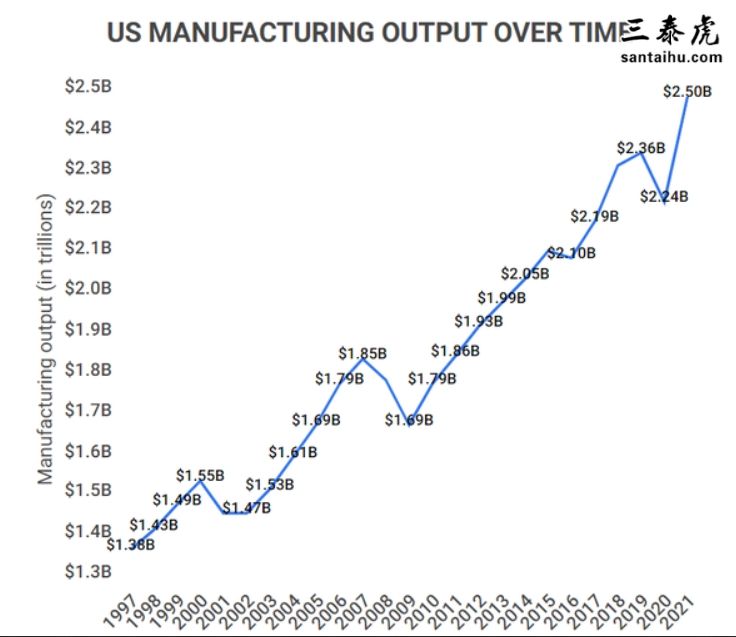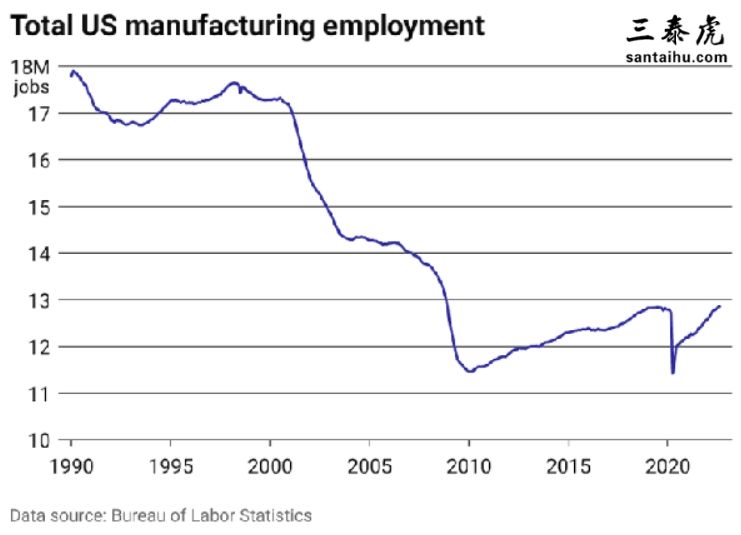If moving manufacturing back to America would drive the price of goods significantly up, then how could people afford goods back when everything was made in America?
如果将制造业迁回美国会导致商品价格大幅上涨,那么在美国制造业外迁之前,美国人是怎么买得起的呢?
以下是Quora网友的评论:
Worldofwonder
This question suffers from generalizations. First of all, not all or even most manufacturing will be coming back to the U.S. Returning manufacturing sectors will be the rare exception (best exemplified by semiconductors), not the rule. The United States is not about to again become internationally competitive in making shoes, clothing, toys, consumer electronics, Halloween costumes, and so on. Our competitive advantage is in sophisticated, high valued-added goods and information technology.
这个问题太过笼统了。首先,并非所有的制造业,甚至多数制造业都不会回流美国。制造业的回流不太可能出现(最好的例子就是半导体)。美国在鞋类、服装、玩具、消费电子产品、万圣节服装等加工方面不可能重获国际竞争力。我们的竞争优势在于精密、高附加值的产品和信息技术。
U.S.-made goods were affordable and price competitive “back when.” The U.S. enjoyed large international trade surpluses, and Americans enjoyed steadily rising incomes and living standards in the decades after World War II. So it was clear that goods made in America were affordable to the average American worker. By the end of the 1970s, however, a seismic shift in international competitiveness was in progress. It was due to the combination of relatively high U.S. wages and the full recovery by Western Europe and Japan from the economic devastation they suffered in World War II.
“过去”美国制造的商品价格实惠,很有竞争力。二战后的几十年里,美国享有巨额国际贸易顺差,美国人的收入和生活水平稳步上升。所以很显然,美国制造的商品对于普通美国工人来说是负担得起的。到20世纪70年代末,国际竞争力发生了翻天覆地的变化,这是美国相对较高的工资水平以及西欧和日本开始从二战遭受的经济破坏中全面复苏等因素合力产生的结果。
A growing percentage of labor-intensive, low and medium-tech goods could now be made more cheaply abroad. Imports increased rapidly. This shift soon accelerated geometrically when China and other Asian countries became world-class manufacturers in record time. Even as wages steadily increased in the U.S., prices of light manufactures on average increased less rapidly—thanks to imports. (This explains why most economists advocate liberal trade.)
如今越来越多的劳动密集型、中低端等技术产品现在可以在国外生产,成本更低。美国的进口迅速增加。当中国和其他亚洲国家在创纪录的时间内成为世界级制造商时,这种转变就以几何级数加速了。虽然美国的工资稳步增长,但进口导致轻工业产品的价格的平均上涨速度较慢(这就是大多数经济学家都支持自由贸易的原因)。
Marshal Ironsides
Because whoever told you that moving manufacturing back to America would drive the price of goods significantly up knows nothing about business, manufacturing, or basic Not Being Stupid.
My guess is it was a leftist who desperately wants Co sm to be a thing that works. It never will be. You can tell them that from me.
因为那些告诉你将制造业迁回美国将导致商品价格大幅上涨的人,对商业、制造业一无所知。
我猜题主是个左翼分子,他迫切希望GC主义成为一种可行之道。
永远都不可能。你就把我的话撂他们面前。
Lynn Fredricks
I don’t think this is quite a reasonable comparison.
As others have said, people did buy fewer things. For example, you generally didn’t by out of season fruit. Now, its ‘in season’ someplace in the world.
我不认为这是合理的比较。
正如其他人所说,以前人们买的东西比较少。举个例子,你过去通常不会买反季节水果对吧。但现在,在世界上的某个地方,这种水果正当季呢。
But now for the ‘reason.’
Moving manufacturing back to America doesn’t need to have as great an impact but, that’s assuming that we’ve made logistics within America more efficient and, we keep automating and in turn, lower the cost of automation. Therefore, manufacturing will require far fewer to be working.
现在说说“原因”。
将制造业迁回美国并不会产生那么大的影响,但也有一个前提:我们能够提高美国国内的物流效率,我们继续推进自动化生产,降低自动化成本。因此,制造业所需的劳动力将大大减少。
Wayne Spillett
The first thing that you need to remember is that in the nineteen-fifties and -sixties, items bought by consumers in the west, including the USA and European countries, were made in the country of sale. There simply wasn't a massive trade in everyday goods.
Since then, an immense amount of production moved out of the west into Asia and Latin America. This was not, as right-wing politicians would have you believe, foreigners stealing your jobs. It was the boards of directors and shareholders of companies in your country chose to give your jobs to people in poorer countries who worked for a fraction of your wages.
你需要记住的第一件事是,在20世纪50年代和60年代,包括美国和欧洲国家在内的西方消费者购买的所有物品,都是在销售国当地制造的,当时日常用品的贸易规模并不大。
后来,大量的生产从西方国家转移到亚洲和拉丁美洲。这并不是像右翼政客宣传的那样,所谓的外国人偷走了你的工作。是你们国内各家企业的董事会和股东们选择了把你们的工作岗位拱手让给贫穷国家的民众,因为他们的工资只有你们的零头。
China has come on in leaps and bound, it is mich more wealthy that it was then, but whilst it has many millionaires, its ordinary folk haven't come on that much and your electronic goods, plastic household items etc cetera are still made by people earning a fraction of what you earn. If these goods were made in your country, the price you pay at the store would have to account for the people who made it being paid your country’s wages.
The only way to bring production back to the west is to reduce the living standards of people in the west so that they are level with or below those of people in Asia and Latin America. Are you prepared for that? Of course you're not, and neither are the folks around you. This is why it will never happen.
中国突飞猛进,比以前富裕多了,虽然中国有很多百万富翁,但普通民众的收入并不太高,你们消费的电子产品、塑料家居用品等都是由只能赚到三瓜俩枣的工钱的人制造的。如果这些商品在你们国家本地制造,你支付的商品价格就必须涵盖赚取当地收入水平的工人的工资。
将制造业回流西方,只会降低西方人民的生活水平,让他们的生活水平与亚洲和拉丁美洲人民持平甚至更低。你做好准备了吗?你当然没有做好准备,你周围的人也都一样。所以这就是制造业永远都不会回流的原因了。
Maxence Gomez
1)People afforded less goods when it was domestically produced.
Take for instance garment.
40 years ago the dominant paradigm was garment domestically produced, used during a few years until worn out . Now the dominant paradigm is garments produced overseas, worn on average only seven times before discarded. That's called fast fashion. Shein is emblematic of the trend.
1)当商品在国内生产时,人们买得起的商品就减少了。
以服装为例。
40年前,国内生产的服装占主导地位,人们会穿个几年,直到穿坏。现在很多服装都是海外生产的,平均穿个7次就会被扔掉。这就是快时尚。希音就是这一趋势的知名品牌。
2)People devoted a bigger chunk of their income to goods.
Now people tend to spend more on services and less on goods. Most of thedisposable income goes to services such as health. housing and rents, college tuition.
Savings made on cheap imported goods have been completely mopped up by the unrelenting inflation in services.
2)人们会把更多的收入用于购买商品。
现在人们会把更多的钱花在服务上而非商品上。大部分可支配收入都用于医疗、房租、大学学费等服务。
因为廉价的进口商品而省下的钱,全都被服务业持续的通货膨胀所吞噬了。
Edward Henry
Because there was less to buy and there was little or no competition for what was available. Middle-class Americans of that era could not and did not buy or get everything they wanted. But what they did buy was generally made in the USA because other nations did not have the infrastructure nor the economy to provide such items.
因为之前可买的商品比较少,而且几乎没有竞争。那个时代的美国中产阶级不能也不会购买他们想要的一切。但他们购买的东西通常都是美国制造的,因为其他国家的基础设施不如美国,经济也不如美国,无法提供那些商品。
As soon as other nations began to produce cheaper versions of items, Americans began to buy them. Japanese cars and china, German cars and optics, Asian textiles and clothing, Italian leathers, toys from Europe, South American fruit, and then electronics from Japan and later Korea and China. Oil from the Middle East was the one place where even Pax Americana was not in the producer’s seat. Instead we dominated through the gold standard and then the petrodollar (which is the axs of attack on current US economic hegemony).
当其他国家开始生产更便宜的产品时,美国人开始购买这些产品,比如日本的汽车和瓷器,德国的汽车和光学元件,亚洲的纺织品和服装,意大利的皮革,欧洲的玩具,南美的水果,然后是日本的电子产品,再后来又是韩国和中国。中东地区的石油是美国在“美式和平”唯一一个无法占据产油国席位的地区。相反,我们通过金本位和石油美元(这是当前美国经济霸权最被诟病的焦点)占据了主导地位。
One at a time, America’s dominance of the domestic economy yielded to less expensive versions via imports. It was a long road full of US economic success, but it also was an inevitable march toward world parity, which we are still leveling off on.
美国在国内经济中的主导地位一步一步地让位给了通过进口进入美国的更便宜的产品。这是一条漫长、彰显了美国经济成就的道路,也是走向世界平等的必然之路,我们现在仍在平稳前进。
Evelyn Jane Saungikar
They had less stuff.
It was typical for kids to share bedrooms, houses were smaller. A friend of mine grew up with 4 siblings in an 850 square foot bungalow, and they were not considered poor.
One car in the family. One TV. A TV cost a month’s take-home pay. A pair of pants cost a day’s pay. Food was more expensive relative to income than today.
People repaired things. They didn’t have 100 pairs of pants.
那个时候,人们拥有的东西比现在少。
孩子们通常会共用卧室,房子也比现在小。我有一个朋友小时候就和四个兄弟姐妹挤在一间850平方英尺的平房里,但他们一点也不穷。
多数人家里只有一辆车、一台电视。一台电视机的价格曾经相当于一个月的到手工资。一条裤子的价格相当于一天的工资。相对于今天的收入,之前食品的价格也要贵得多。
东西坏了,人们会修好急需用。他们也不会购买100条裤子。
Kenneth Lundgren
We were content with less. Homes were smaller. Most homes and cars were not air-conditioned. Most people didn't have color TV. We had one phone. Sometimes on a party line. No cell phones. No VCRs or DVDs. More people rode trains, buses, and street cars. We didn't have a car.
Color TV, VCRs, and PCs didn’t become affordable until they were imported from low wage countries.
过去,我们更容易满足:房子比现在小,大多数家庭和汽车都没有装空调。大多数人也没有彩色电视机。我们只有一部电话,有时候还是共线电话。没有人拥有手机。也没有录像机或影碟机。有更多的人出门时搭乘火车、公共汽车和有轨电车。我们没有小轿车。
直到我们开始从低收入国家进口彩电、录像机和个人电脑,人们才负担得起这些商品。
The first Color TVs cost $850 (with much lower income). The first VCRs were $750 to $1200. (ditto). American-made cell phones were $800 (ditto). IBM PCs were $2000 without a hard drive but dual floppy drives and 4.5 MHz CPU speed.
第一台彩电售价850美元(比人们的收入要高得多)。第一台录像机的价格在750美元到1200美元之间(同上)。美国制造的手机售价800美元(同上)。没有安装硬盘驱动器的IBM个人电脑售价2000美元,但配有双软盘驱动器和4.5 MHz的中央处理器速度。
Douglas Whiteside
Here, let me show you something:
来,我给你看样东西:

The chart above shows manufacturing output in the U.S. is higher than it has ever been. It is manufacturing employment that is down, mostly due to automation.
上面的图表显示,美国的制造业产量比历史上任何时候都要更高。制造业的就业人数下降,主要是由于自动化。

There is plenty of manufacturing going on in the U.S., more than ever before in fact. So this talk of moving manufacturing back to the U.S. is mostly bullshit. And bringing back those manufacturing jobs would mean mothballing all of the machines that are now doing a lot of the work, to replace them with human labor. That is not going to happen.
美国境内还有大量的制造业存在,实际上比历史上任何时候都要多。所以,把制造业迁回美国的说法基本上就是扯淡。把这些制造业的工作岗位带回美国,意味着要封存现在大量正在工作中的机器,用人力来取代机器。但这是不可能发生的。
Now, about those “good old days” when everything was made in America. The folks doing the making could also afford to do some buying because the U.S. had not yet adopted the “trickle down” economics of Reagan. Back then, most of those manufacturing jobs were union jobs. That means they had decent wages and at least some protections against being summarily dismissed.
现在,我们来谈谈所谓的所有商品都是美国制造的“美好的过去”。由于美国还没有采纳里根的“涓滴效应”的经济模式,制造业的工人也是有能力购买的。当时,这些制造业工作大多是工会工作,这意味着工人们拥有体面的工资,至少在一定程度上不会被随意解雇。
While there are fewer and fewer manufacturing jobs in the U.S., there are all sorts of service industry jobs. Unfortunately, a great many of those jobs don’t pay a liveable wage.
虽然美国制造业的工作岗位越来越少,但服务业的工作岗位却五花八门。但不幸的是,其中很多工作岗位的工资都无法维持生计。
To summarize, there is plenty of manufacturing going on in the U.S., it just doesn’t take as many people as it used to. And there are plenty of non-manufacturing jobs in the U.S., they just don’t pay a liveable wage. All it takes for that to change is for our elected officials to grow a pair and start supporting working Americans instead of the uber-wealthy.
总而言之,美国现在还有大量的制造业,只是不像过去那样需要那么多的工人了。美国也有很多非制造业的工作岗位,就是工资难以维持生计。要改变这种状况,我们的民选官员需要拿出勇气,支持工薪阶层的权益,而不是超级富豪的权益。
此文由 三泰虎 编辑,未经允许不得转载!:首页 > 大国 » 如果将制造业迁回美国会导致商品价格大幅上涨,那么在制造业外迁之前,美国人是怎么买得起的呢
 为什么中国迟迟不愿将西方商品从市场上剔除,如果西方制裁中国,中国也可以以牙还牙,用国产商品取代美国商品
为什么中国迟迟不愿将西方商品从市场上剔除,如果西方制裁中国,中国也可以以牙还牙,用国产商品取代美国商品 为什么中国过去和现在都在制造业领域取得了成功
为什么中国过去和现在都在制造业领域取得了成功 为什么中国向高端制造业转型的速度比日本慢很多
为什么中国向高端制造业转型的速度比日本慢很多 为什么在中国的中国人吃得比美国人少,他们一年只需要花费1320美金
为什么在中国的中国人吃得比美国人少,他们一年只需要花费1320美金 普通美国人应该做些什么来阻止中国超越美国
普通美国人应该做些什么来阻止中国超越美国 如果不再依赖中国制造的消费品,美国人能撑下去吗
如果不再依赖中国制造的消费品,美国人能撑下去吗 欧洲主流学者承认:中国现在是“全球唯一的制造业超级大国”,外国网友评论
欧洲主流学者承认:中国现在是“全球唯一的制造业超级大国”,外国网友评论 世界的未来就在中国,美国人看到这些后哭了
世界的未来就在中国,美国人看到这些后哭了